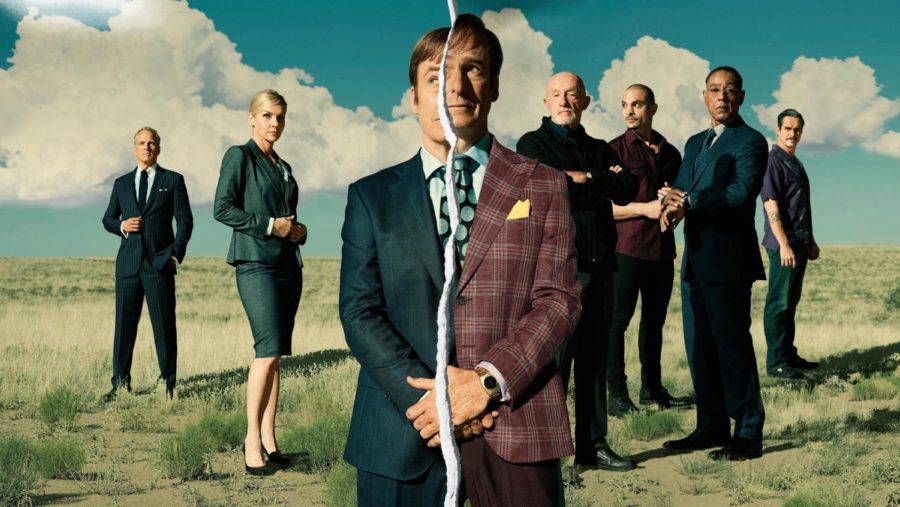Saul-utations: Vince Gilligan Signals the End of an Era
The series finale of “Better Call Saul,” the prequel to “Breaking Bad,” was released on Aug. 15, providing fans of the 15-year saga the conclusion that they’ve been waiting for.
On Aug. 15, fans of the hit television series “Breaking Bad” immersed themselves in the harrowingly realistic and deeply poignant universe that Vince Gilligan constructed nearly 15 years ago for one final time. The prequel series “Better Call Saul,” lauded by some critics as the greatest prequel series ever made, and possibly better than its groundbreaking parent series “Breaking Bad,” carved out a path in television that will likely never be seen again.
Detailing the rise of attorney Jimmy McGill (Bob Odenkirk), eventually working under the name Saul Goodman, “Better Call Saul” allows fans to reconsider “Breaking Bad” because it gives them something new to chew on. The titular character longingly lingers in the shadows of his successful older brother Chuck McGill (Michael McKean); his awe-inspiring performance gets lost in the mix of excellency around him. Chuck McGill is a member of the firm Hamlin, Hamlin & McGill (HHM), along with Howard Hamlin (Patrick Fabian). Jimmy starts out in the mailroom at HHM, while earning his degree from the University of American Samoa Law School. It is while working in the mailroom that Jimmy meets Kim Wexler (Rhea Seehorn), an attorney at HHM. Eventually Jimmy and Kim start dating and form a relationship that is already considered to be in the canon of tragic television love stories. After getting his law degree, Jimmy is not given a position at the firm, causing Jimmy to go out and pursue his own business, along with Kim. After seeing his future success, Howard invites Jimmy back, and it is this act of goodwill by Howard that sets in motion many of the key events that cause a tumultuous downfall of many characters in the final season.
Fans are also introduced to Nacho Varga (Michael Mando) who, despite starting off with a crowd of cartel members—including Tuco Salamanca (Raymond Cruz), from the original series—finds his way working alongside Jimmy, and makes the ultimate sacrifice to protect himself, his father and his reputation. In the latter half of the series, Lalo Salamanca (Tony Dalton) plays a key role in the plot, making plans against Gustavo Fring (Giancarlo Esposito), before getting floored by the fried-chicken slinging, methamphetamine kingpin. The audience also welcomes back some familiar faces from “Breaking Bad,” including Gus Fring, Tuco, Hector Salamanca (Mark Margolis) as well as fan favorite Mike Ehrmantraut/Finger (Jonathan Banks). Brief cameos are also made by Bryan Cranston and Aaron Paul, reprising their illustrious roles as Walter White and Jesse Pinkman, respectively.
Throughout the series, viewers bear witness to the rise of Jimmy McGill and, more profoundly, the reasons for his actions as Saul Goodman in “Breaking Bad.” Upon first watch, I viewed his character as nothing more than comedic relief and disregarded his character in the scheme of the rest of the story. However, upon a second watch of “Breaking Bad,” and watching “Better Call Saul,” I can only applaud Odenkirk’s choices as an actor. The sentiment should also be extended to Vince Gilligan for writing such a tragic character and presenting him as the sharp antithesis of one. Jimmy lives in a constant state of trying to impress Chuck, even attending law school at the University of American Samoa in an attempt to be more relatable. This ultimately fails, as the house-ridden Chuck, struck with a disorder known as electromagnetic hypersensitivity (EHS), still takes his brother to court and suffers the first judicial misstep of his career. As a result of Chuck’s disrespect, Jimmy starts practicing law under the name Saul Goodman because he wants to break free of the psychological stronghold Chuck held over him, and to be seen as his own person, not “Chuck’s brother.”
The prequel series defied all predictions of how it would end. Rather than focusing on Saul’s eventual run in with Walter and Jesse, the show focuses on Saul’s life following the events of “Breaking Bad.” After being caught, Saul receives another new identity, Gene Takovic, and works as a manager of a Cinnabon inside an Omaha shopping mall. It is a sad decline for the character, who earlier in the series saw a meteoric rise through his toxic manipulation of those closest to him. In the final episodes, we see him take advantage of an elderly neighbor, Marion (Carol Burnett) who delivers a stunning act of dramaturgy. I will not spoil everything here, but the show ends on a satisfying note—not one necessarily of high or low standing, but one that completes the story of a universe that left fans reeling for a decade and a half.
In today’s digital landscape, with an ever-increasing number of original series put out by streaming services tailored to more specific niches of society, “Better Call Saul”—and “Breaking Bad” before it—shows audiences the unequivocal feeling of connectedness and relatability of prestige television. It did not pander to its audience and did not take their intelligence or consumption in vain. Rather, it rewarded viewers for giving the show a chance. As executive producers, Vince Gilligan, Peter Gould and Thomas Schnauz aimed to create a story containing a realistic narrative, and with a streaming service’s 90-second preview for a 15-year long saga, much can get lost in translation.
“El Camino: A Breaking Bad Movie” as well as the first five seasons of “Better Call Saul” can be viewed on Netflix, and the latter can be enjoyed in its entirety on AMC+.


